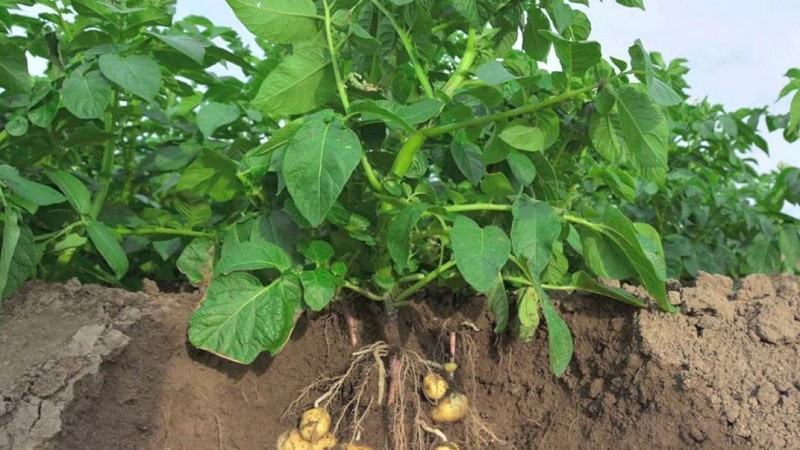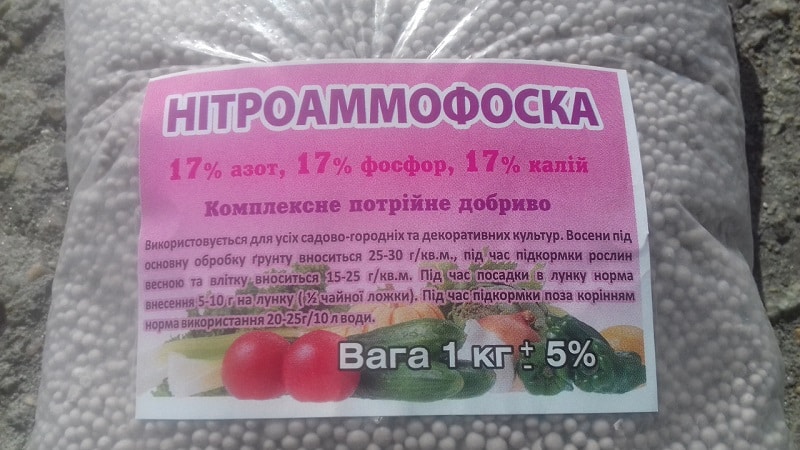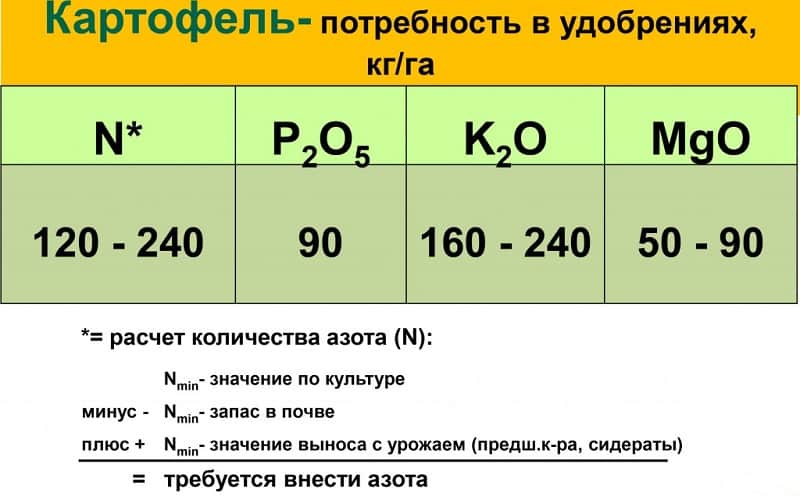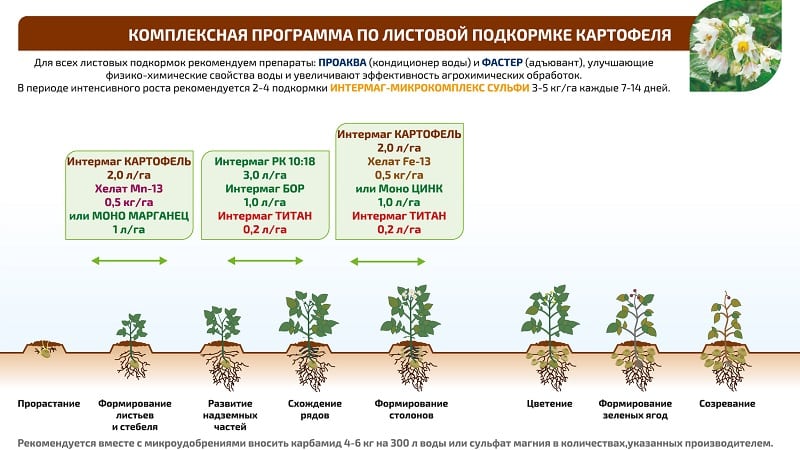The best recipes for foliar feeding of potatoes and rules for their application
During the process of growth and development, potatoes absorb a lot of nutrients. In addition to the traditional root method of fertilizing, gardeners carry out foliar fertilizing. An integrated approach increases productivity, plant resistance to diseases and pests, and makes tubers larger and tastier.
Features of foliar feeding
With the conventional method of fertilizing, many vegetable crops are deficient in nutrients or absorb them unevenly. During foliar treatment, the above-ground parts of plants are sprayed - elements quickly absorbed through stems and leaves.
Reference! This method will help to urgently revive bushes that are severely weakened and are not able to absorb fertilizers from the soil.

Advantages and disadvantages
Advantages of foliar feeding:
- beneficial substances are absorbed almost instantly, as they are quickly absorbed through the tissues of leaves and stems and activate metabolic processes;
- potato yield increases;
- Preparations for treatment are used more economically;
- the crop becomes less vulnerable to diseases and pests;
- The skin of the tubers thickens, the amount of ascorbic acid and starch increases.
In acidic soil, this type of fertilizing is more effective than traditional fertilizing.: it allows you to control your diet and promptly eliminate the deficiency of useful components. The method is suitable for weakening and fading of the potato root system.
The main disadvantage of this method — the risk of exceeding the norm of the drugs used. At high concentrations and non-compliance with dosages, burns appear on the bushes and the leaves die off.
Signs of a lack of substances
Diagnosis is carried out both by leaves and tubers. By the appearance of the bushes it is easy to determine what nutrients they lack:
 calcium - growth stops, tubers become deformed and covered with mucus;
calcium - growth stops, tubers become deformed and covered with mucus;- magnesium - tubers are not formed due to weak synthesis of carbohydrates in leaf blades;
- zinc - resistance to drought and temperature changes decreases, tubers become smaller, do not contain vitamins and starch;
- copper - growth slows down, potatoes become deformed;
- chlorine - stems and leaves develop poorly, plants are often affected by fungus;
- manganese - productivity decreases due to impaired development of the root system;
- nitrogen - leaves turn yellow, tubers form poorly;
- phosphorus - the foliage takes on a dark purple hue, vegetables slowly gain weight.
A lack of potassium is indicated by the drying edges of the leaves.. This component is added along with phosphorus for better absorption.
The best foliar feedings
For such treatments use organic and mineral compounds.
Nitroammofoska
Nitroammophoska - an effective means for feeding potatoes, stimulating crop growth and tuber formation. Due to the high concentration of nitrogen, phosphorus and potassium, other substances with a similar composition are not used. The use of nitroammophoska increases productivity by 30–70%.

For processing potatoes 2 tbsp. granules are diluted in 1 bucket of warm water, spray the bushes after sunset or on a cloudy day.
Mineral supplements
Mineral complexes for potatoes are extremely important: they stimulate the growth of bushes and the tubers themselves. Often gardeners use:
- a solution of potassium and nitrogen (for 5 liters of water take 100 g of urea, 5 g of boric acid, 150 g of potassium monophosphate);
- phosphorus compounds (20 g of fertilizer per 10 liters of water, leave for 2 days).
One of the effective remedies is ammonium nitrate.. Take 5–10 g of the drug per 10 liters of water. This volume is enough to process 100 m2 plot.

Folk remedies
Infusions of ash and manure are effective against pests, and nettle decoction prevents diseases:
- Add water to the brim in a bucket 1/3 filled with manure and let it brew for 6-7 days. After 1 liter of the prepared solution, dilute it in 10 liters of warm water and spray the tops.
- Add 200 g of ash to 10 liters of water, leave for 5 hours and use for irrigation. To enhance the effect, add shavings of laundry soap to the product.
- Nettle tops along with stems are poured with warm water and left until active fermentation. Then they are filtered and the bushes are treated once every 10 days.
An effective remedy against Colorado potato beetles — infusion of walnut leaves. To prepare 2-3 kg of raw materials, pour a bucket of water and leave for 1-2 weeks. Before use, strain twice.
To restore damaged tops from hail or to nourish plants after frost, use herbal decoction: 700–800 g of dried horsetail, pour 10 liters of water, leave for a day, then bring to a boil and filter.
Take note:
How to grow a bucket of potatoes from one bush
Terms of fertilizing
Before planting, fertilizers are usually applied to the hole, but some summer residents treat the tubers directly. On young seedlings, leaves quickly absorb micro- and macroelements.
During landing
Before planting the tubers, ash is poured into the prepared holes. Each bag of potatoes requires 1 kg of product.
In open ground, the first foliar feeding is carried out 15 days after germination.. During this period, plants need nitrogenous fertilizers. For 1 hectare of land, use 2 kg of urea diluted in 20 liters of warm water.

Before and after flowering
Before flowering, potatoes need potassium, copper, and molybdenum. After the first shoots appear, the crop is sprayed with this product to stimulate growth.:
- 3 tbsp. l. wood ash;
- 1 tbsp. l. potassium sulfate;
- 10 liters of water.
Before flowering, apply a complex composition of 20 g of superphosphate, 0.1 g of copper sulfate and 2 g of nitrate. All elements are diluted in a bucket of water and the tops are sprayed.
A decoction of onion peels is used as a folk remedy.. It repels beetles and slugs as it contains phytoncides. To prepare the product you will need 10 liters of water and 3 large handfuls of husks. The mixture is brought to a boil and filtered.
Important! Foliar treatment with mineral fertilizers is not carried out during the flowering period, as plants become especially sensitive to any chemical components. Potent substances repel pollinating insects.
After flowering, potatoes are treated with potassium compounds: For 1 bucket of water take 30–40 g of potassium sulfate. This composition increases the sugar content of tubers.
25–30 days before harvest, the crop is fed with superphosphate: 100 g of the drug is dissolved in a bucket of water. This volume is enough for 100 m2 plot.
Against late blight use a solution of 5 g of boric acid and 1-2 g of potassium permanganate, diluted in a bucket of water.

Step-by-step instruction
With foliar feeding It is important to observe not only the fertilizer application regime, but also their dosage.
Application rates
When preparing compositions for irrigation take into account the characteristics of the variety and soil, weather conditions:
- early varieties require the most nutrition - foliar treatment promotes a rapid and more balanced supply of substances to all parts of the plant;
- due to frequent rains, the crop poorly absorbs phosphorus, zinc, manganese, nitrogen and sulfur, and in the heat there is a deficiency of boron, calcium and potassium;
- In acidic soil, potatoes lack molybdenum and phosphorus; in alkaline soil, they lack boron.
It is recommended to first test the selected product on a small area., and then spray all plantings.
When using ready-made medications, follow the instructions and the indicated dosage. A decrease in the concentration of a substance is allowed, but not an increase.

Precautionary measures
To avoid thermal burns on the tops, bushes are not sprayed on a sunny day.. The best time is after sunset or at dawn.
By the way! Plants need at least 2 hours to absorb substances.
When carrying out work, use protective equipment: masks, gloves or special suits. This prevents hazardous substances from entering the skin, respiratory tract and mucous membranes.
It is important that the solution gets not only on the top side of the leaves, but also on the bottom. This contributes to a more uniform and rapid absorption of elements into plant tissues.
Advice from experienced summer residents
Some important tips from experienced gardeners:
- Foliar feeding is not carried out if rain is expected in the coming days: it will wash away all the nutrients from the tops, and they will not reach the roots. Fertilizers will remain in excess in the soil, which will lead to its oversaturation with nitrates.
- For maximum efficiency, use clean water for spraying, standing for at least 2 days, or well water.
- To increase yield by 20%, use an organomineral complex - potassium humate. Take 200 ml of the drug per 10 liters of water. Plantings are sprayed in the phase of 5–7 leaves and before flowering.
Conclusion
Foliar feeding of potatoes improves plant development, tuber formation, and increases yield. Complex application of nutrients makes the crop resistant to diseases and insect pests.
When processing leaves, useful elements quickly reach the root part and tubers, restoring weakened bushes. At different stages of the growing season, both mineral and organic compositions are used.